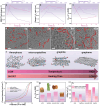Joule Heating-Driven sp2-C Domains Modulation in Biomass Carbon for High-Performance Bifunctional Oxygen Electrocatalysis
- PMID: 40246802
- PMCID: PMC12006640
- DOI: 10.1007/s40820-025-01725-0
Joule Heating-Driven sp2-C Domains Modulation in Biomass Carbon for High-Performance Bifunctional Oxygen Electrocatalysis
Abstract
Natural biomass-derived carbon material is one promising alternative to traditional graphene-based catalyst for oxygen electrocatalysis. However, their electrocatalytic performance were constrained by the limited modulating strategy. Herein, using N-doped commercial coconut shell-derived activated carbon (AC) as catalyst model, the controllably enhanced sp2-C domains, through an flash Joule heating process, effectively improve the edge defect density and overall graphitization degree of AC catalyst, which tunes the electronic structure of N configurations and accelerates electron transfer, leading to excellent oxygen reduction reaction performance (half-wave potential of 0.884 VRHE, equivalent to commercial 20% Pt/C, with a higher kinetic current density of 5.88 mA cm-2) and oxygen evolution reaction activity (overpotential of 295 mV at 10 mA cm2). In a Zn-air battery, the catalyst shows outstanding cycle stability (over 1200 h) and a peak power density of 121 mW cm-2, surpassing commercial Pt/C and RuO2 catalysts. Density functional theory simulation reveals that the enhanced catalytic activity arises from the axial regulation of local sp2-C domains. This work establishes a robust strategy for sp2-C domain modulation, offering broad applicability in natural biomass-based carbon catalysts for electrocatalysis.
Keywords: sp 2-C domains; Carbon-based catalyst; Joule heating; Natural biomass; Oxygen electrocatalysis.
© 2025. The Author(s).
Conflict of interest statement
Declarations. Conflict of Interest: The authors declare no interest conflict. They have no known competing financial interests or personal relationships that could have appeared to influence the work reported in this paper.
Figures






Similar articles
-
Nonmetallic Phosphorus-Driven Oxygen Vacancy and Electronic Structure Modulation Enhancing Bifunctional Catalytic Activity of Cobalt-Based Spinel Air Electrode for Rechargeable Zn-Air Batteries.ACS Appl Mater Interfaces. 2025 Aug 20;17(33):47057-47069. doi: 10.1021/acsami.5c10617. Epub 2025 Aug 5. ACS Appl Mater Interfaces. 2025. PMID: 40765139
-
In-Situ Nanoarchitectonics of Fe/Co LDH over Cobalt-Enriched N-Doped Carbon Cookies as Facile Oxygen Redox Electrocatalysts for High-Rate Rechargeable Zinc-Air Batteries.ACS Appl Mater Interfaces. 2024 Apr 24;16(16):20360-20374. doi: 10.1021/acsami.3c19483. Epub 2024 Apr 15. ACS Appl Mater Interfaces. 2024. PMID: 38619401
-
Coupling CoNi-LDH and Fe2N Nanoparticles on N-Doped Biomass-Derived Carbon as Oxygen Electrocatalyst for Rechargeable Zn-Air Batteries.Small. 2025 Jul;21(29):e2502145. doi: 10.1002/smll.202502145. Epub 2025 May 23. Small. 2025. PMID: 40405629
-
A rapid and systematic review of the clinical effectiveness and cost-effectiveness of topotecan for ovarian cancer.Health Technol Assess. 2001;5(28):1-110. doi: 10.3310/hta5280. Health Technol Assess. 2001. PMID: 11701100
-
Management of urinary stones by experts in stone disease (ESD 2025).Arch Ital Urol Androl. 2025 Jun 30;97(2):14085. doi: 10.4081/aiua.2025.14085. Epub 2025 Jun 30. Arch Ital Urol Androl. 2025. PMID: 40583613 Review.
References
-
- L. Xie, C. Liang, Y. Wu, K. Wang, W. Hou et al., Isomerization engineering of oxygen-enriched carbon quantum dots for efficient electrochemical hydrogen peroxide production. Small 20(37), e2401253 (2024). 10.1002/smll.202401253 - PubMed
-
- Q. Ni, S. Zhang, K. Wang, H. Guo, J. Zhang et al., Carbon quantum dot-mediated binary metal–organic framework nanosheets for efficient oxygen evolution at ampere-level current densities in proton exchange membrane electrolyzers. J. Mater. Chem. A 12(45), 31253–31261 (2024). 10.1039/D4TA06855F
-
- S. Liu, Y. Zhang, B. Ge, F. Zheng, N. Zhang et al., Constructing graphitic-nitrogen-bonded pentagons in interlayer-expanded graphene matrix toward carbon-based electrocatalysts for acidic oxygen reduction reaction. Adv. Mater. 33(42), e2103133 (2021). 10.1002/adma.202103133 - PubMed
-
- P. Cui, L. Zhao, Y. Long, L. Dai, C. Hu, Carbon-based electrocatalysts for acidic oxygen reduction reaction. Angew. Chem. Int. Ed. 62(14), e202218269 (2023). 10.1002/anie.202218269 - PubMed
LinkOut - more resources
Full Text Sources
